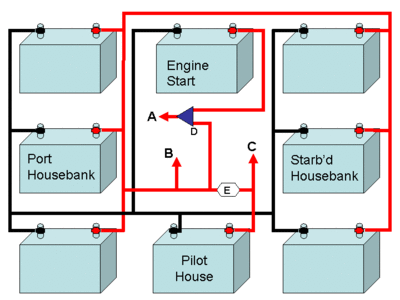BatteriesLayout
Layout of the Batteries
Summary
AAmpere (amp), SI unit of electrical current virtual house bank of batteries can be split into two physical banks for better load distribution. A separate battery can be put in the Pilot House, for all instruments and emergency lights if there is an electrical failure. Bilge pumps can be wired directly to the batteries with suitable fusing. Each engine fitted has its own starter battery.
Virtual House Bank
There is a lot of discussion about whether you should have one or two separate house banks. The idea behind two banks is that you also have two separate charging systems, thus there is good redundancy in the system. But it is clear that for maximum electrical efficiency and battery life, you should have one virtual house bank.
One house bank also satisfies Occam’s razor. If necessary, this virtual house bank can be divided into two physical banks to better distribute weight.
The exception is that you could put a separate battery in the Pilot House, for all instruments and emergency lights. Normally, it would be in the charging circuit for the house bank, but in an emergency it could be switched out and isolated using a fail-open relay with a manual bypass switch. In an emergency, this will preserve communications and navigation instrumentation independently of other demands.
The major disadvantage is having to run long heavy-duty cables from the engine room to the pilothouse. The distance will not be too long with a midships engine room, but an aft engine room could require 40-50 ftFoot of cable. In this situation, you are strongly advised to plan for a 24-VDCVolts direct current or higher system. Or, you could trickle charge this battery locally using an ACAlternating current source.
Bilge pumps may be wired directly to the batteries, and if so, are provided with in-line fuses. The battery banks are fully metered.
Each engine fitted has its own starter battery, and a 1-2-Both switch that will allow it to be started by either start battery or, in an emergency, the house bank.
